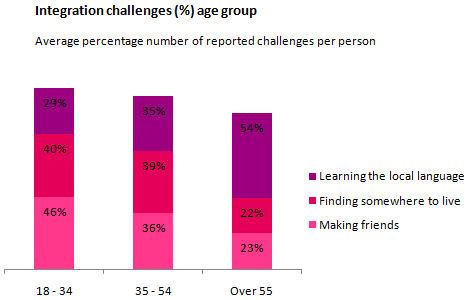The chart below shows information about the challenges people face when they go to live in other countries.
Summarise the information by selecting and reporting the main features, and make comparisons where relevant.
The given chart reveals about the percentage integration challenges based on age group when they immigrate in. Generally, there are three age groups which are; 18-34, 35-54 and over 55, and three aspects which are being appraisal of reported challenges per person.
Turning to the data, for age group 18-34, the new place (40%) and friendship (46%) are the main challenge aspects when they move to a new country, while language-learning is the easy one for them to be learnt with 29 percent. Standing in contrast, older people, aged over 55, get an obstacle to learn the second language with 54% difficulties level. However, they are more easily for making friends and finding somewhere for living, over 20 percent.
A more detailed look at the chart depicts that balancing the percentage of problem aspects for people, who have aged 35 to 54, are stable in approximately above 35%. In contrast, adults have lowest percentage in local language, while language-learning is the main problem of elderly people. Moreover, the data shows more doubled percentage (23% to 54%) of reported challenges widely regarding to people's ages.
In conclusion, each age group has different problem when they adapt in the new environment. Perhaps, people have different understanding about problem-solving skill to reduce culture shock.
Summarise the information by selecting and reporting the main features, and make comparisons where relevant.
The given chart reveals about the percentage integration challenges based on age group when they immigrate in. Generally, there are three age groups which are; 18-34, 35-54 and over 55, and three aspects which are being appraisal of reported challenges per person.
Turning to the data, for age group 18-34, the new place (40%) and friendship (46%) are the main challenge aspects when they move to a new country, while language-learning is the easy one for them to be learnt with 29 percent. Standing in contrast, older people, aged over 55, get an obstacle to learn the second language with 54% difficulties level. However, they are more easily for making friends and finding somewhere for living, over 20 percent.
A more detailed look at the chart depicts that balancing the percentage of problem aspects for people, who have aged 35 to 54, are stable in approximately above 35%. In contrast, adults have lowest percentage in local language, while language-learning is the main problem of elderly people. Moreover, the data shows more doubled percentage (23% to 54%) of reported challenges widely regarding to people's ages.
In conclusion, each age group has different problem when they adapt in the new environment. Perhaps, people have different understanding about problem-solving skill to reduce culture shock.

immigrate.png
